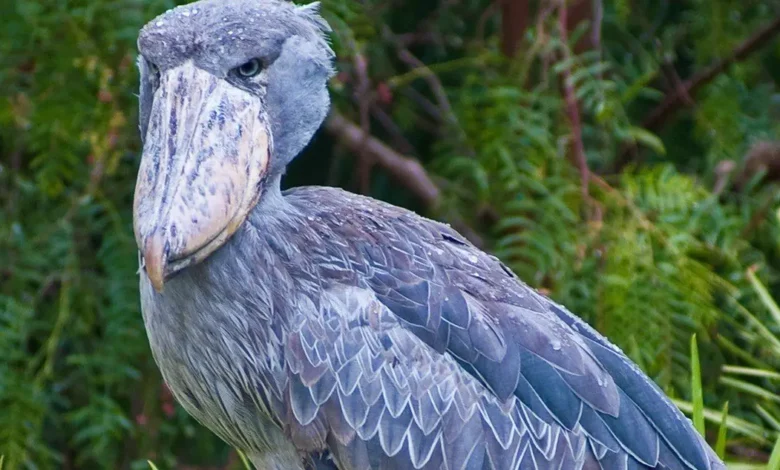Shoebill Stork Sound: Fascinating Calls and Their Meanings

Introduction
The shoebill stork, a strikingly unique bird native to the swamps and wetlands of East Africa, captivates ornithologists and bird enthusiasts alike. With its imposing stature and prehistoric appearance, the shoebill stork is as intriguing for its behaviors as it is for its distinctive sounds. Understanding the vocalizations of this majestic bird is crucial for appreciating its complex communication system and its role within its ecosystem. This article delves into the various sounds made by the shoebill stork, their significance, and how to observe and record them, offering a comprehensive guide to these enigmatic vocalizations.
1. Understanding the Shoebill Stork
The shoebill stork (Balaeniceps rex) stands out with its large, shoe-shaped bill, which is both a tool for hunting and a key feature in its vocalizations. Native to the wetlands of Central Africa, particularly in countries like Uganda, Zambia, and Tanzania, this solitary bird is adapted to life in swampy areas. It possesses a commanding presence with a height of up to 5 feet and a wingspan that can reach nearly 8 feet. The bird’s plumage is a mix of grey and blue, complemented by a rugged bill that is perfect for catching fish and other prey.
In terms of behavior, the shoebill stork is known for its slow, deliberate movements and its preference for solitary living. It spends much of its time standing still, waiting for prey to come within striking distance. This bird is also known for its unique courtship rituals and territorial displays, which often involve a series of vocalizations. These behaviors are essential for understanding the full context of the sounds the shoebill stork produces, as they are integral to its communication and social interactions.
2. The Nature of Shoebill Stork Sounds
The shoebill stork produces a range of vocalizations, each serving a specific purpose. One of the most iconic sounds is the “clapping” noise, which is made by snapping its bill together. This sound is often used during courtship displays or as a territorial warning. The clapping noise can be surprisingly loud and is often described as a resonant, clattering sound that can carry over long distances. This vocalization is crucial during the breeding season when shoebill storks are establishing and defending their territory.
Another notable sound is the “grunt” or “growl,” which is a low-frequency noise that the shoebill stork makes when it feels threatened or is communicating with its mate. This sound is less conspicuous than the clapping noise but is equally important for maintaining social bonds and coordinating activities with other storks. Understanding these sounds requires careful observation and often the use of specialized recording equipment to capture the nuances of the shoebill stork’s vocal repertoire.
3. Significance of Shoebill Stork Sounds
The vocalizations of the shoebill stork play a crucial role in its communication and social interactions. The clapping sound, for example, is not just a display of dominance but also serves as a means of attracting a mate. During the breeding season, males use this sound to demonstrate their fitness and to establish a territory that will be attractive to potential mates. This vocal display is a critical part of the courtship process and helps to ensure that shoebill storks can successfully reproduce and raise their young.
In addition to courtship and territorial displays, shoebill stork sounds are also indicative of the bird’s emotional state. For instance, the low growl is a signal of discomfort or threat, allowing other shoebill storks to gauge the level of danger and react accordingly. These sounds are integral to maintaining the social structure within a population and ensuring that interactions between individuals are managed effectively. By studying these vocalizations, researchers can gain insights into the behavior and ecology of the shoebill stork, contributing to conservation efforts and enhancing our understanding of avian communication.
4. Observing and Recording Shoebill Stork Sounds
To observe and record shoebill stork sounds, it is essential to approach the task with careful planning and the right equipment. Shoebill storks are typically found in remote and difficult-to-access wetlands, so being prepared for challenging conditions is crucial. Field guides and local wildlife experts can be invaluable resources in locating these birds and understanding their habits. Observers should also be equipped with high-quality binoculars and cameras to capture visual and audio data without disturbing the birds.
Recording the sounds of shoebill storks requires specialized equipment, such as directional microphones and sound recorders that can capture low-frequency noises. It is important to position recording devices strategically to avoid interference from other noises and to ensure that the sounds are captured clearly. Researchers often use playback devices to analyze the recordings in a controlled environment, allowing them to study the nuances of the shoebill stork’s vocalizations in detail.
5. Fascinating Facts About Shoebill Stork Sounds
Shoebill stork sounds have captured the interest of scientists and bird enthusiasts alike due to their unique characteristics and the insights they provide into the bird’s behavior. For instance, the clapping noise made by the shoebill stork is one of the loudest bird calls, with some reports indicating that it can be heard from over a kilometer away. This remarkable sound is not only a communication tool but also a feature of the stork’s impressive courtship displays.
Research on shoebill stork sounds has revealed intriguing details about their vocal repertoire and its role in their social interactions. For example, studies have shown that the sounds made by shoebill storks can vary depending on their geographic location and social context, indicating a level of regional variation and adaptability. These findings contribute to our understanding of avian communication and highlight the importance of conserving habitats where shoebill storks can thrive and continue their unique vocal practices.
Conclusion
The sounds of the shoebill stork are as fascinating as the bird itself. From the resonant clapping noise used in courtship displays to the low growls that signal discomfort, these vocalizations play a critical role in the shoebill stork’s communication and social interactions. Observing and recording these sounds provides valuable insights into the behavior and ecology of this remarkable species. By studying and preserving the shoebill stork, we not only protect a unique bird but also enhance our understanding of avian communication and the complexities of the natural world.


